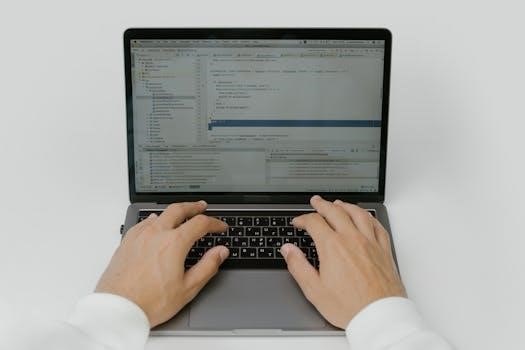Understanding Toyota Remote Programming
Toyota remote programming is the process of synchronizing your key fob with your vehicle’s system. It allows you to control keyless entry functions like locking and unlocking doors. Manual programming offers a DIY approach to this synchronization, saving time and money.
What is Toyota Remote Programming?
Toyota remote programming is the process of teaching your car to recognize a new or replacement key fob. Instead of the dealer, this allows you to lock, unlock, and sometimes even start your vehicle remotely. Many Toyota models offer a manual programming procedure, which allows owners to sync their remote without special tools. This method involves a sequence of steps performed inside the car, such as turning the ignition and opening/closing the doors. Successfully programming a Toyota key fob manually puts you in control of your vehicle’s security and convenience features, offering a cost-effective solution.

Prerequisites for Manual Programming
Before attempting manual programming, ensure your Toyota model and year support this method. You’ll also need a compatible, unprogrammed remote and the vehicle’s key. Verifying these elements is crucial for a successful programming attempt.
Compatibility Check⁚ Model and Year
Prior to starting any programming procedure, it’s absolutely vital to confirm that your specific Toyota model and production year are compatible with manual remote programming. Not all Toyota vehicles support this DIY method; compatibility often depends on the vehicle’s electronic architecture. Consult your owner’s manual or a reliable online Toyota resource to verify that manual remote programming is an option for your car. This step is a critical first line of defense, preventing wasted effort and possible complications. Ensure you cross-reference the year and model against known compatible lists. Failure to verify compatibility can lead to frustration and wasted time.
Required Items⁚ Remote and Key
Before attempting to manually program your Toyota remote, ensure you have all the necessary items readily available. First and foremost, you will need the remote itself, making sure it’s a compatible replacement for your Toyota model. Secondly, you’ll require the physical key that starts your vehicle. This key will be used to cycle the ignition during the programming sequence. Having these two items at hand will streamline the process and prevent interruptions. It is also beneficial to have the owner’s manual nearby for reference. Double-check that the remote has a fresh battery installed to avoid any power-related issues during programming.

Step-by-Step Manual Programming Procedure
The manual programming procedure involves a specific sequence of actions performed inside your Toyota. This process includes entering programming mode, synchronizing the remote, and then testing the functionality to ensure successful programming.
Entering Programming Mode
To initiate the Toyota remote programming, you must first enter programming mode. Begin with the driver’s door open and unlocked, and the key removed from the ignition. Insert and remove the key from the ignition switch twice within five seconds. Next, close and open the driver’s door twice within 40 seconds; Insert the key into the ignition and remove it again. Following this, close and open the driver’s door twice again. Insert the key and close the door. Turn the ignition to on (without starting the engine) and then off. Remove the key. The door locks should cycle automatically, indicating that the vehicle has entered programming mode. If the locks don’t cycle, repeat the process.
Remote Synchronization
Once your Toyota is in programming mode, the next step is remote synchronization. With the new remote you are trying to program, press the lock and unlock buttons simultaneously for approximately 1.5 to 2 seconds. Release both buttons and immediately press and hold the lock button on the remote for 2 seconds. If successful, the door locks should cycle once, confirming that the car has accepted the remote. If you are programming multiple remotes, repeat this step for each additional remote within the given time frame. The locks cycling multiple times could indicate acceptance of multiple remotes. Remember to perform these actions promptly to maintain programming mode.
Testing the Remote
After completing the synchronization process, it’s crucial to test the newly programmed remote to ensure it functions correctly with your Toyota. Exit programming mode by opening the driver’s door. Once the programming mode is exited, attempt to lock and unlock the doors using the remote‘s buttons. Verify that the panic button also triggers the alarm system as expected. If the doors respond correctly to the lock and unlock commands, and the panic button activates the alarm, the remote has been successfully programmed. If any of these functions fail to work, repeat the entire programming procedure from the beginning, ensuring each step is followed precisely. Successful testing confirms proper integration of the remote with your vehicle.

Troubleshooting Common Issues
Manual Toyota remote programming can sometimes present challenges; Common issues include locks not cycling during programming or the remote failing to respond after the procedure. Addressing these problems often involves repeating steps carefully or seeking alternatives.
Locks Not Cycling
If the door locks fail to cycle during the programming process, it indicates that the vehicle has not entered programming mode correctly. Ensure all doors are closed, and repeat the “Entering Programming Mode” steps precisely. Double-check the timing of key insertions and removals, as well as door opening/closing sequences. A slight deviation can prevent the system from initiating the programming sequence. Also, confirm that the key is fully inserted and removed each time. If issues persist, verify the vehicle’s compatibility with the programming procedure and the remote‘s functionality. Consulting a professional may also be necessary.
Remote Not Responding
If the remote is not responding after programming, first verify the battery is functional and correctly installed. Re-synchronize the remote by repeating the “Remote Synchronization” steps. Ensure that you press the lock and unlock buttons simultaneously for the specified duration, and then press the lock button individually. The vehicle’s locks should cycle to confirm successful synchronization. If the issue remains, the remote may be incompatible with the vehicle or faulty. Try programming a different remote to rule out vehicle issues. If multiple remotes fail, consult a Toyota technician for further diagnosis and repair.
Alternatives to Manual Programming
If manual programming fails or seems too complex, consider professional programming services offered by Toyota dealerships or automotive locksmiths. Key fob programmers also provide an alternative, offering a potentially simpler method for remote synchronization.
Professional Programming Services
Toyota dealerships and certified automotive locksmiths offer professional programming services for your key fobs. Opting for this route ensures compatibility and proper synchronization, eliminating potential DIY errors. While it may incur higher costs compared to manual programming, it provides peace of mind, especially if you’re unfamiliar with the procedure.
Technicians possess specialized equipment and expertise to accurately program your Toyota remote. They can also address any underlying issues that might prevent successful programming. This eliminates troubleshooting and ensures that your key fob functions seamlessly with your vehicle’s security system. The cost of Toyota Smart keys including programming can range from $260 to $400.
Using a Key Fob Programmer
Key fob programmers are specialized devices designed to simplify the remote programming process. These tools, often available for rent or purchase, connect to your vehicle’s OBD port and guide you through the synchronization steps. They eliminate the need for manual procedures, potentially reducing errors.
These programmers typically come with pre-loaded software and instructions tailored to specific Toyota models, ensuring compatibility. They streamline the process, making it more accessible for individuals with limited technical expertise. Tom’s Key Company rents smart key fob programming devices. Some programmers also offer advanced features, such as key cutting and diagnostic capabilities, providing added value.

Security Considerations
DIY remote programming carries potential security risks, like unauthorized access if not done correctly. Always ensure you follow secure procedures. After programming, verify the system’s integrity to prevent vulnerabilities.
Potential Risks of DIY Programming
DIY Toyota remote programming, while cost-effective, presents certain risks. Incorrect procedures can lead to system malfunctions, rendering the remote useless or, worse, compromising the vehicle’s security. If steps aren’t followed precisely, you might inadvertently disable existing keys or create a vulnerability for unauthorized access.
Furthermore, some aftermarket remotes may not be fully compatible, causing unpredictable behavior or failure. Always use a compatible remote and adhere strictly to the programming instructions. If unsure, seeking professional assistance is advisable to avoid potential complications and ensure your vehicle’s security remains intact. This includes getting Toyota Smart keys.
Ensuring Security After Programming
After programming your Toyota remote, verifying its functionality is crucial for security. Test all buttons – lock, unlock, and panic – to confirm proper operation. If you programmed multiple remotes, test each one individually. Be aware of the safety system included.
Regularly check the remote’s responsiveness to detect any anomalies. If you suspect unauthorized access or unusual behavior, consider reprogramming the remote and changing the vehicle’s key codes. This will ensure no one else can access your car. For enhanced security, consult a professional locksmith or Toyota technician to assess and reinforce your vehicle’s security system.

